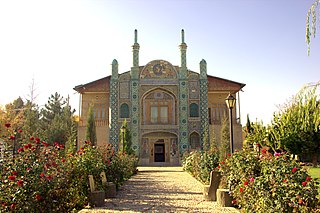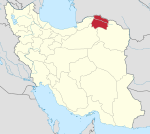
Khorasan, also called Traxiane during Hellenistic and Parthian times, was a province in northeastern Iran until September 2004, when it was divided into three new provinces: North Khorasan, South Khorasan, and Razavi Khorasan.

Tabas is a city in the Central District of Tabas County, South Khorasan province, Iran, serving as capital of both the county and the district.

South Khorasan province is one of the 31 provinces of Iran, located in the eastern part of the country. Its capital is the city of Birjand. In 2014, the province was placed in Region 5.

Razavi Khorasan province is one of the 31 provinces of Iran, located in northeastern Iran. Its capital is the city of Mashhad, the second-most-populous city in Iran.

Greater Khorasan is a historical eastern region in the Iranian Plateau in West and Central Asia that encompasses western and northern Afghanistan, northeastern Iran, the eastern halves of Turkmenistan and Uzbekistan, western Tajikistan, and portions of Kyrgyzstan and Kazakhstan.

Esfarayen County is in North Khorasan province, Iran. Its capital is the city of Esfarayen.

Shirvan County is in North Khorasan province, Iran. Its capital is the city of Shirvan.

Esfarayen is a city in the Central District of Esfarayen County, North Khorasan province, Iran, serving as capital of both the county and the district.

Bojnord is a city in the Central District of Bojnord County, North Khorasan province, Iran, serving as capital of the province, the county, and the district. It is about 701 km (436 mi) from Tehran. and 237 km away from Mashhad, the capital of Razavi Khorasan province.
Mohammadabad is a village in Atrak Rural District of the Central District of Maneh County, North Khorasan province, Iran. It became the capital of Atrak Rural District after transfer from the village of Pish Qaleh, and the capital has now been transferred once again to the village of Bazareh-ye Qarnas.
Qazi is a city in, and the capital of, Samalqan District of Samalqan County, North Khorasan province, Iran. It also serves as the administrative center for Qazi Rural District.
Pish Qaleh is a city in the Central District of Maneh County, North Khorasan province, Iran, serving as capital of both the county and the district. As a village, it was the capital of Maneh Rural District until its capital was transferred to the village of Mohammadabad, from which it was transferred again to Bazareh-ye Qarnas.
The Central District of Bojnord County is in North Khorasan province, Iran. Its capital is the city of Bojnord.

Maneh County is in North Khorasan province, Iran. Its capital is the city of Pish Qaleh, whose population at the time of the 2016 National Census was 2,001 people in 611 households.
Gifan Rural District is in Garmkhan District of Bojnord County, North Khorasan province, Iran. Its capital is the village of Gifan-e Bala.
Jeyransu Rural District is in the Central District of Samalqan County, North Khorasan province, Iran. Its capital is the village of Garmab.
Qazi Rural District is in Samalqan District of Samalqan County, North Khorasan province, Iran. It is administered from the city of Qazi.
Bazareh-ye Qarnas is a village in, and the capital of, Atrak Rural District of the Central District of Maneh County, North Khorasan province, Iran. The previous capital of the rural district was the village of Mohammadabad, and prior to that, its capital was the village of Pish Qaleh, now a city.
Khartut is a village in, and the former capital of, Shirin Su Rural District of Shirin Su District, Maneh County, North Khorasan province, Iran, serving as capital of the district. The capital of the rural district has been transferred to the village of Shahrak-e Kal Imani.
Zard is a village in Qazi Rural District of Samalqan District, Samalqan County, North Khorasan province, Iran.



















